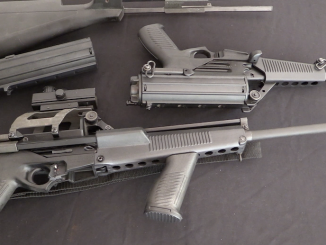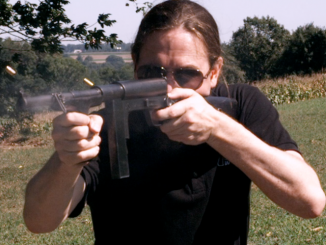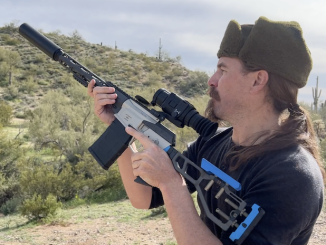We have reached the final iteration of the Winchester lever action rifle development story today, the Model 1895. This was another John Browning design, although the locking system is basically the same as the 1894 but with the bolt extending over the top of the locking block and hiding it from sight.
The new feature of the Model 1895 was the replacement of the traditional tube magazine with a single stack box magazine located under the action. By this time, spitzer (pointed) bullets were becoming commonplace, to exploit the new high velocities made possible by the new smokeless powders. In a tubular magazine, these pointed bullets would rest on the primer of the next cartridge in the magazine, and ran the risk of causing rounds to detonate in the magazine tube under recoil. The box magazine, of course, negated this danger completely.
The Model 1895 was built around the .30-40 military cartridge, although was initially released in two black powder chamberings. It would eventually be offered in a wide variety of chamberings, including .30-03, .30-06, .303 British, and the .405 Winchester – Theodore Roosevelt’s “Big Medicine”. In addition, more than half of the total production (nearly 300,000 rifles) would be for the Russian military, with the rifles chambered for 7.62x54R and fitted with stripper clip guides.




Forgotten Weapons forgot the Winchester Model 88, (and the various Winchester lever-action rimfire rifles). ^__^
My first rifle was a Winchester 250 – the .22 companion to the 88. Great gun. Spent the summer I turned 12 mowing yards to save up the $62 that Western Auto was charging.
One would think that this would be great for left-handed users in that loading and charging is not dependent upon dominant hand orientation. The only problem is that one cannot reload in prone position easily. Why did the 1895 rifle have to be fitted with the socket bayonet with no cutting edge instead of a knife?
Correction, I saw a sword bayonet after searching. My mistake. But why did the US Army not adopt this to accompany the M1903 Springfield? I just don’t get why the top brass sought to “play by traditionalist rules.” Or did I mess up again?
“US Army not adopt this to accompany the M1903 Springfield”
Why they did have? To have two different designs full-filling same role, requiring different training for armorers and separate supply chains of spare parts? Russian Empire only bought it because they needed guns (any guns) as fast as possible (or faster) – they considered Mosin rifle design to be superior, but Model 1895 could be delivered faster.
I am also a bit skeptical that Mosin was as bad as labeled here. Otherwise it would have been phased out and never seen WWII. Even now as I understand it is of interest to enthusiasts across the U.S. Also Finns would unlikely have based their own line of (improved) rifles on it.
“Mosin was as bad as labeled here”
Why it is supposed to be bad? Why it is believed to be inferior – it don’t see any grand disadvantage over other military repeating rifles adopted in 1890s.
“it would have been phased out and never seen WWII”
Soviet Union worked on getting working self-loading/automatic rifle, at least since early 1920s, this was hard task, and first to be mass produce become AVS (Simonov) adopted in 1936.
There is not much practical difference in utility between a spike (socket) bayonet and sword bayonet. The latter can cut, but it’s still too long to be used as a knife. The edges were usually not very well suited for use as a general cutting tool, either. The same applies mostly to early long and narrow 10-12″ knife bayonets as well. As a fighting tool the edged bayonet could deliver draw and push cuts, but 99.9% of soldiers did not have enough bayonet training for such advanced techniques, and neither should they have had: a bayonet is primarily a thrusting weapon and training soldiers with repeating rifles for advanced bayonet techniques would have been just waste of time.
A short but sturdy knife bayonet would do for actual field utility and emergency melee combat. The spike bayonet and sword bayonet were specialized for stabbing your intended victims to death and that was that. Not very useful when most enemies try to kill you from over 100 meters away with small arms and artillery. On the other hand, forgetting to teach basic close-quarters combat techniques will render your men prone to getting hacked/stabbed/bludgeoned to death in trench fights or in places where long arms are impractical to use. During this time period, enlisted men were not given handguns at all… or am I wrong?
in 1895, long muskets fitted with long bayonet where still required (or requested?) to fight against cavalry
Yes, that is essentially correct. While first knife bayonets were introduced in the late 1800s, it took more 50 years for the concept to mature and become the modern general-purpose “bayonet-knife”. The Austrians with the M1895 had the best idea what a modern bayonet should be, but it was still a bit too long and narrow-bladed to be a good general-purpose knife.
The need for bayonets as anti-cavalry weapons in the late 19th and early 20th century is debatable. The traditional cavalry charge as a tactic in set-piece battles was obsolescent. On the other hand, cavalry charges remained dangerous for any light (or “leg”) infantry in unprepared positions (that is, on the march or in a so called meeting engagement) all the way to WW2. As long as the standard personal weapon was a bolt action rifle loaded with stripper clips, the bayonet could still be useful in the anti-cavalry role, at least in theory. Practice is somewhat different, though, since even in WW1 most infantry had minimal training in using their bayonets against cavalry. The rushed conscript training during the war did not have time for such finesse, and of course in the Western Front there was no need for it, either, between 1914 and Autumn 1918.
Mechanically, it’s basically just an 1886, but when you get a chance I’d love to see a video on the model 71.
In researching the .405 Winchester cartridge, Wikipedia says that Teddy Roosevelt never called the rifle “big medicine” but rather his “medicine gun.” They believe writers of the era conflated his “big stick” speech with his “medicine gun” quote. Pity, “big medicine” does sound more… bully!
It’s actually funny in hindsight that Theodore Roosevelt had a somewhat high-pitched voice. Most people would think he’d sound like the actors portraying him in film. Teddy’s asthma was partly to blame (and Teddy mitigated his asthma, or perhaps strangled it to death, by drinking strong coffee)…
Did I mess up?
Theodore Roosevelt was a sickly child who forced his way into being a hardy adventurer. By all rights he could have, and should have, got a desk job in the city. Instead he forced himself to be tough. He apparently lost the sight in one eye from a boxing match. He left New York to operate a cattle ranch in the bad lands out west. He was terribly near sighted. He liked shooting, but was not a very good shot. When he was running for President (after leaving office) he was about to give a speech when an anarchist shot him in the chest. Roosevelt gave his speech, then went to the hospital.
Andrew Jackson was another president who started out as a sickly individual. He too forced his way forward through sheer force of will. Before the Battle of New Orleans his hosts laid out a fine dinner, but all he could digest was hominy, corn (maize) soaked in lye. Although he was 6 feet tall (1.83M) he only weighed 145 Lbs (66Kg). Later in life he had a duel with a man named Dickinson. Dickson was the better shot and Jackson knew it. But Jackson hated Dickinson so badly that he did not care. Jackson just stood there as Dickinson fired. Jackson remained standing even though he had been hit in the chest. Jackson wore a heavy coat and Dickinson did now know exactly where Jackson’s skinny self was in that big coat and he narrowly missed his heart. By dueling rules the party that first fired had to stand still at their line. Jackson took careful aim and shot Dickinson right in the stomach, a painful wound from which Dickinson bleed to death several hours later. The bullet next to Jackson’s heart was never removed although it caused him discomfort for the next 40 years. Then a few years later he was in a fight in a hotel in Nashville and was shot twice. About twenty years after that, as President, a slug in his arm from the Nashville fight was causing problems so it was cut out, without anesthesia.
Very good addition to my knowledge of US presidential history. Thanks.
“US presidential history”
I hear anecdotal history how Roosevelt become president.
In late 19th century he become New York Police Department (NYPD) Commissioner and started reform of it (at that point in time it was corrupted and not effective). This was not good for some high-ranked individuals, but they can’t fire Roosevelt as it much liked by public opinion, so they decided to give him higher post and thus Roosevelt become Vice President (in 1890s this title give very little power in reality), but soon president McKinley was killed (see: Leon Czolgosz) and that mean Roosevelt become president.
Documents with him made during his speeches always made impression on me that he wanted to appeal to ordinary man and not as a member of elite. He succeeded by his own example, by his conduct and strong will.
My Son has an 1895 Winchester that has been passed down through the family since my Great Uncle purchased it. I have always loved the 1895 ever since I saw a picture of Teddy Roosevelt with one. This is a strong action. As I recall this was the only lever action that was strong enough to handle the pressure of the 30:06. Great series on the Winchester lever ction rifles.
Sorry Ian, the 30-40 Krag had a round nose bullet, just like the 30-03. Only the 30-06 got a sptizer bullet.
The Russian contract made the 1895 the only Winchester lever gun whose most common variant is the musket.
I had one of those russian one which was converted in 9x57R Mauser in germanic style. It still had its stripclip guide. So I tried loading with Mosin clip event thought the rim is way smaller. The springy feed lips are not always cooperative. A round or two often popped out when removing the clip or closing the bolt. This must be related to the different cartridge taper. My gunsmith tried to fix it without success. Even when using the push and flip load trick, pressure from the new round was sometimes enough to free the previous one.
Last thing, the 1895 receiver is very large. I had a Lyman receiver sight fitted to mine. We had to use the model designed for the 1886 and I had to set the peep hamfway to the right to get it centered.
Excellent conclusion of great series!
The lever action came to end of its development quite naturally since it did not provide transition to self-loading rifles as the bolt action allowed. Mr. Browning made a monumental contribution in this area and the series obviates his contribution.
“it did not provide transition to self-loading rifles as the bolt action allowed”
Though, lever-actions, spawned some machine guns, inspiration for method of locking might be found in Maxim machine gun (and machine guns its spawned), inspiration might be also found in Colt Potato Digger machine guns (as it uses swinging lever)
“lever action came to end of its development”
I can’t agree, lever-action found further development in form of Browning BLR rifle: https://en.wikipedia.org/wiki/Browning_BLR
There was also the contemporary Sako Finnwolf, although it’s not manufactured any longer. Both it and the BLR are hybrids design with a rotating bolt head locking system, so one could claim that they are not “true” lever-actions but rather lever-operated bolt action rifles, or something to that effect. Finnwolf VL63 manual: http://www.sako.fi/sites/default/files/Finnwolf.pdf
Euroweasel,
I think this is a false distinction. All of the rifles featured in this series have a running bolt with the only thing distinguishing them being the locking mechanism used and the cartridge feeding method. The Winchester Model 88 is no less a “lever-action” since the locking mechanism is operated by a lever. The Savage 99 uses a tipping bolt lockup and a rotary magazine, but nobody that I know would call that action a “hybrid,” it’s a lever-action rifle. “Bolt-action” rifles also use a variety of locking mechanisms. Although a rotating bolt is the most common it is not the only way that they lock up.
“are not “true” lever-actions”
Does Savage Model 99 – https://en.wikipedia.org/wiki/Savage_Model_99 – counts as proper lever-action? It seems to be further development, considering cartridges it can chamber, also hammerless make time from trigger squeeze to fire smaller.
After further consideration I agree with Brian, so yes, the Savage 99 and even the Finnwolf and BLR would count as developments of the lever-action rifle.
Earlier developmental versions of what became the Savage 1899, were entered into the US army rifle trials, from which the Krag and Jorgensen was adopted.
Interestingly, the Savage had the cartridge counter stipulated for the trials, but the Krag and Jorgensen didn’t.
Apparently there’s a 1950s prototype in the Savage headquarters museum of a 99, lengthened to accommodate 30-06 length cases.
Savage 99s were factory chambered for.284 Winchester, although it is reckoned that case life is short, due to the stretch inherent in rear locking actions.
The 06 length prototype would (theoretically at least) be capable of taking .376 steyr and its parent, the 9.3×64 breneke, as well as 9.3×62,
a lever action in genuine African big game cartridges (and the Russian heavy sniper and anti materiels round).
Even more earlier there were “Levermatic” Marlins using “Roller assisted accelerators” providing sufficient action distance with shorter than normal strokkes. “Rack and Pinion” BLR action should be developped for a better response for same short stroke action with stronger, foul proof mechanism.
I wonder about possibility of utilizing Winchester’s Super Short Magnum cartridges: https://en.wikipedia.org/wiki/Winchester_Super_Short_Magnum
in lever-action – it smaller length (than .30-06) mean possibility of creating lever action with smaller “angle of opening” of lever (this may have other proper name, but I don’t know it – I mean angle between lever in FULLY OPENED position and in FULLY CLOSED).
It should be named as “Stroke”, meaning; cycling distance.
“Action” should refer to the type of mechanism carrying the breechbolt from and to the barrel for ejection and loading as occuring in a distance longer than the cartridge used, “Lock” should refer to the kind of joint fastening the breechbolt to the barrel for keeping the back of breech closed at least, at the instant of firing as occuring in a very short distance from the breech. IMHO.